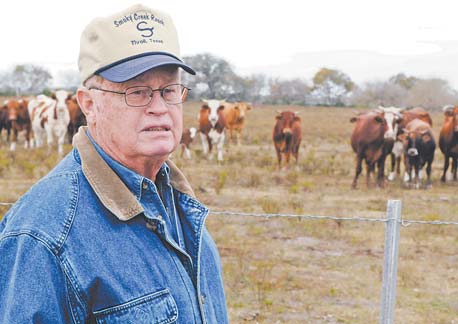Oil spill brings attention to coast

Rancher Dallas Ford talks about his cattle in Tivoli, Texas. Ford has put in new fencing to keep his cattle in separate fields to prevent them from chewing the grass too far down and force them to drink out of strategically located troughs.
Associated Press
TIVOLI, Texas
For decades, farmers and fishermen along the Gulf of Mexico watched as their sensitive ecosystem’s waters slowly got dirtier and islands eroded, all while the country largely ignored the destruction.
It took BP PLC’s well blowing out in the Gulf — and the resulting environmental catastrophe when millions of gallons of oil spewed into the ocean and washed ashore — for the nation to turn its attention to the slow, methodical ruin of an ecosystem vital to the U.S. economy. Last month, more than a year and a half after the spill began, the U.S. Department of Agriculture announced a three-year, $50 million initiative designed to improve water quality along the coast.
“I’m not going to say that it’s the silver lining,” Will Blackwell, a district conservationist with the USDA’s Natural Resources Conservation Services, said of the oil spill. Blackwell is one of many regional officials who have long worked with farmers and ranchers to fence cattle, reseed native grasses and take on other seemingly inane projects that go a long way toward preventing pollution and coastal erosion.
“I’m going to say that it will help get recognition down here that we have this vital ecosystem that needs to be taken care of,” he said. “This will keep it at the forefront.”
NRCS administrators struggled for years to divide a few million dollars among farmers and ranchers in the five Gulf states. Now, they are getting an eleven-fold increase in funding, money that will allow them to build on low-profile programs that already have had modest success in cleaning crucial waterways by working with farmers and ranchers to improve land use practices.
The nation’s focus turned sharply to the Gulf when the Deepwater Horizon drilling rig blew up in April 2010. Images of oil-coated birds and wetlands were splashed across newspapers and cable news networks. Coastal wetlands that are habitat to all sorts of wildlife were soiled and oyster beds were wiped out, underscoring the Gulf’s ecological and economic importance.
The project is called the Gulf of Mexico Initiative, the first concrete step from a year’s worth of meetings, studies and talking by the Gulf Coast Ecosystem Restoration Task Force, a committee formed by President Barack Obama in the spill’s wake.
Sometimes, the money is spent on simple projects, such as building fences and installing troughs to keep cattle away from rivers and creeks that flow into the Gulf. The minerals in cow manure can pollute those upstream waters and then flow into the ocean. Those minerals can deplete oxygen in the Gulf, creating “dead zones” where wildlife can’t thrive.
Other times, the program pays for expensive farming equipment that turns soil more effectively and creates straighter rows. That helps keep fertilizers on the farm — where it helps crops — and out of the Gulf, where the nutrients choke oxygen from the water. This equipment also decreases erosion, which has eaten up hundreds of miles of Gulf Coast habitat in the past century.
 43
43
